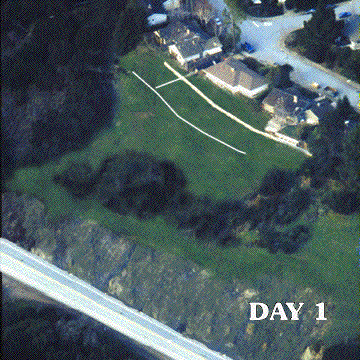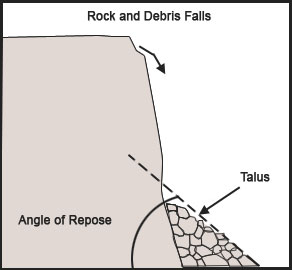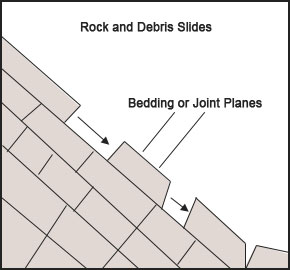Slides
On the playground slide, your body slides down a plastic incline. Similarly, there is a broad type of mass movement called "slides," which are any type of movement that occurs when materials behave as rigid solids that detach from a surface and move downward under gravity. It is like your body leaving the top of the playground slide and sliding downward. Slides result in the transport of material down a hill by rolling, sliding, falling, or slumping. Click through the tabs to learn more about slides and the mass movement caused by these slides.
Slumps

Slumps are the rapid movement of materials down a curved surface. They usually take place over a short distance and always involve downward rotation of rock or soil along a curved surface, as shown in this image. During slumping, the upward surface of the moving material remains relatively undisturbed and materials move downward in large blocks. Slumps are common along road cuts where slopes have been steepened by construction, and along river beds. Sudden slumps are also common after earthquakes or heavy continuing rains, but they do not require complete saturation of the soil to take place—they may take place with dry soil as well as wet soil.

After several days of heavy rain San Mateo County, California, this slump began when material near the homes began sliding downward. Notice how after several days, the material has slumped downward all the way to the road and has covered the road. Over 250,000 tons of rock and soil moved in this slump.
Falls

Falls occur when materials become dislodged and fall down a slope. Rock falls involve falling rocks, and debris falls involve a mixture of rocks, soils, and vegetation. Falls are most common on steep cliffs, and they often result in the accumulation of materials at the bottom of the cliff. The pile of accumulated material at the bottom of the slope is called talus material.
Rock and Debris Slides

Rock and debris slides are a kind of mass movement that involves the sliding of materials down a surface. They are different from slumps in that they do NOT involve a curved surface. They occur when the stability of a slope changes from stable to unstable, or when the ground can no longer resist the shear stresses acting on it. The loss of stability can be caused by earthquake vibrations, vibrations from machinery or loud blasts, heavy rainfall that saturates the ground, or wildfires and other human activities that strip a sloped area of its protective vegetative cover. Where slope is steep and water content is high, rock and debris slides can be very fast moving.